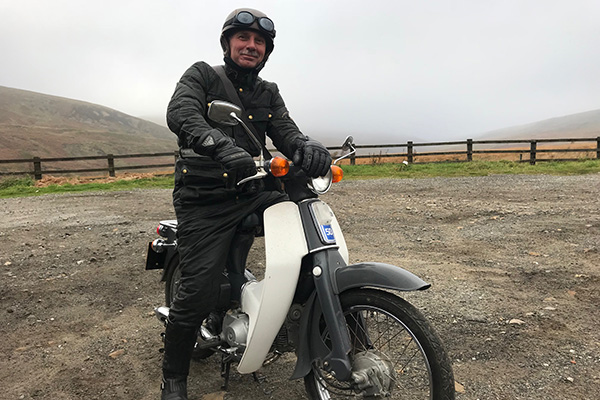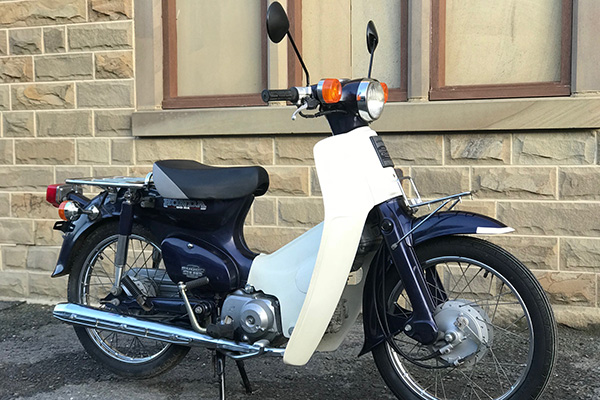Irony On Wheels: The 100 Million Production Run Honda - With Growing Rarity Value.
The Honda Super Cub seems to defy one of the key influences upon something becoming desirable or collectable: rarity. Honda built more than 100 million Cubs. Hardly a low volume bike.
Mark Gibson of Seven Seas Motors in Leeds, which specialises in Japanese classics, says more than 100 hundred million may have been sold since 1958, but they were never a valued commodity until relatively recently. However, they were - and are - deeply-loved.
What Cubs have is authenticity. The majority of the most desirable classics never pretend to be anything other than what they are - that's epitomised by the Super Cub.
For many over-50s a Cub played a range of parts in their formative transport-buying years, whether owned and used by dad as a ride-to-work bike, or as their very own first wheels because they were cheap to run - and, not being terribly cool, less attractive to bike thieves.
But that meant they were low-budget bikes, and went through eras of being seen as little more than disposable.
Cubs imported from Japan can be in generally better original condition - and other than minor specification differences dictated by local laws, there's very little difference between Cubs that were sold in different markets.
For instance, UK-spec bikes have a longer pillion seat, while Japanese-spec machines have a single seat and a luggage rack - a nod to their roles in life. In the UK, the Cub was and is a commuter bike, while in Japan they were and are more often load-carrying working motorcycles.
The shape, style and formula has varied little since 1958.
"There are so many versions that the Super Cub. It came out in '58, called the C100. That had an OHV engine, and they went to an OHC engine, in the C50, from 1962," said Mark.
"Not only was there the C50, C70 and C90, there was the CT110 - a trail version for the Australian Postal Service.

"Then there was a short run of a bike called the C65 for three years in the late sixties, and you had the MD version, which was the 'mail delivery' version, but the C50 and the C90 were the key versions of these bikes.
"Back in the '70s and '80s you would exchange them for ten quid and a packet of crisps and you'd take the leg shields off and hack around the field before you were old enough to ride legally.
"They were absolutely disposable. They weren't valued commodities in terms of an investment in any way, shape or form. They were hardly worth anything, but they were deeply, deeply loved and they were used.
"Back in 2015 you'd struggle to see £1,000 for a C50 - even a nice one. But now a C50 is getting close to £2,000. People are older, we've got bigger bikes, but we remember the C50 and C90 and love them for their simplicity and robustness, and the classic looks and the healthy memories.
"Japan's peak motorcycle production was about 25 years ago, and it's been in steady decline since then. Not dramatic, but it's never been as it was in the late '80s and early '90s.
"So every year there are fewer and fewer of the classic C50 and C90 Cubs around - there aren't actually that many in original condition. The ones that were used regularly in the '70s or '80s have either rusted away or been abused to death - or been restored. It's a relatively small market if you're looking for one.

"Probably the rarest version is the C65, which was only made between 1965 and 1968. It was just one of those 'let's try this' things that Honda did. For whatever reason, it didn't take off. At end of the day Honda is a business, and somebody just said: 'Right, that didn't hit expectations, let's move on.
"We've only ever had two, and they were close to £3,000 - and they were original, not massively tidy. They're just very hard to find.
"You would buy a C50 or a C90 to use, or to do up yourself, but if you bought a C65, you'd be buying it to keep in your collection and probably not do anything to it."
But confirming what was decidedly un-cool back in the day can suddenly change status, older Cubs are now being bought by 17-year-olds because they like the classic looks.
"There's nothing else quite like it," says Mark Gibson - even if modern-day mimics still try to cash in on something that remains fundamentally close in both design and spirit to the 1958 original.

COMMENT